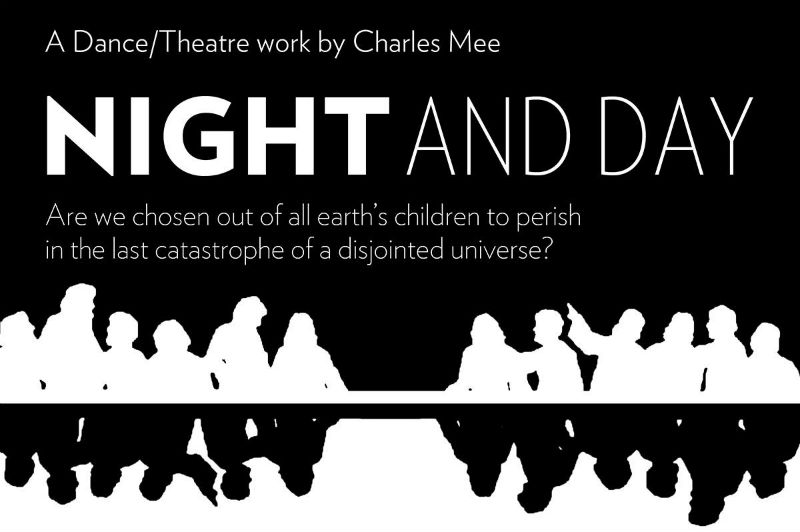Bloody Good Times: Neighborhood Theatre Group's "Black Cat Cabaret"

Music! Dance! Drama! And a wee bit of blood!
All that and more will feature in the Neighborhood Theatre Group's annual hit Halloween show, Black Cat Cabaret, which runs October 19 and 20 at Bona Sera Underground in Ypsilanti. Not appropriate for young children, Black Cat features live musical accompaniment by the NTG “Haunted” House Band, a cash bar, costume contest, and raffle.
Pulp spoke with NTG company member Greg Pizzino and Tom Hett of the House Band about the show.
Out of Chicago: Roscoe Mitchell and the Art Ensemble anchor the 22nd Edgefest

The theme for the 22nd annual Edgefest (Oct. 17-20) is “Chicago - OUT Kind of Town,” celebrating the city's rich legacy of avant-garde jazz and new music, which is strongly rooted in the vision of the Association for the Advancement of Creative Musicians (AACM). One of the first members of this collective, which formed in 1965, was saxophonist/multi-instrumentalist Roscoe Mitchell, who in 1969 spun off the Art Ensemble of Chicago (ACM) from AACM along with trumpeter Lester Bowie, bassist Malachi Favors, saxophonist Joseph Jarman, and percussionist Don Moye.
Mitchell and AACM musicians are guests at Edgefest this year -- along with numerous other Chicago musicians and likeminded explorers -- and their appearances are a launching point for an anniversary celebration of the Art Ensemble.
“This is the first performance of this 50th-anniversary project and Roscoe has written music for this group based on music written for the Art Ensemble years ago by Joseph Jarman, Malachi Favors, and Lester Bowie,” said Deanna Relyea, Edgfest’s artistic director. (Bowie and Favors are deceased; Jarman is retired.) “So, in many ways, it’s a premiere of music based on the past, looking to the future.”
Open Book: Hip-hop MC and singer Dessa reveals her life and loves in "My Own Devices"

On the song “5 Out of 6” from her latest album, Chime, Dessa raps:
I'm out here, arms wide
Hiding nothing
I've done it all in broad daylight
And I left the cameras running
That’s an apt characterization of her new autobiography, My Own Devices: True Stories From the Road on Music, Science, and Senseless Love, too, where he chronicles her 15-year career with the fiercely independent Minneapolis hip-hop collective Doomtree. The book is an honest, clever, humorous appraisal of her family, career, and P.O.S., the Doomtree rapper with the highest profile and the longtime love of Dessa’s life. He’s referred to as X throughout the book because that’s what he is -- her ex-boyfriend. He’s still a member of Doomtree, and for years Dessa and P.O.S. have done the delicate dance to keep their group together and their solo careers growing even as their romantic relationship swung wildly between emotional hills and valleys as they rode coast to coast in a tour van.
“The task was to try to hide that, to try to not look like we weren’t getting along, and I’m sure we failed miserably at that and the tension was obvious,” Dessa said by phone between flights. “But a lot of times, I think we were able to keep the tension out of the van, to keep it to ourselves, keep it in the back with our luggage. That meant being nice, being cordial, making sure nobody had to worry about us.”
Sense of Place: Two books by U-M professors explore Jewish culture, arts, and community

People need a place beyond home and workspace. Community, this sense of “third place” and placemaking, is featured prominently in How the Other Half Looks: The Lower East Side and the Afterlives of Images by Sara Blair and A Rich Brew: How Cafes Created Modern Jewish Culture by Shachar M. Pinsker.
The authors, both professors at the University of Michigan, say that their books began at the Frankel Institute for Judaic Studies. Both were part of a fellowship named Jews in the City, which brought together scholars from a variety of disciplines and led to publications about topics such as Tel Aviv’s Old Cemetery, the Jewish Ghetto of Turin, and the Soviet Shtetl.
Grantstand: The Idle Moments Project celebrates the guitar artistry of Grant Green

It's not an insult to say jazz guitarist Grant Green favored feel over technique. He didn't play double-time phrases or blaze with extended chords, instead favoring a languid, minimalist style that feels more like a blues singer's phrasing transferred to the fretboard. Green's single-line-focused playing was always lyrical, melodic, and funky, which is one of the reasons he was one of the most recorded musicians in the history of Blue Note Records.
Alex Anest, leader of the Ann Arbor Guitar Trio, became so enamored with Green's playing that he decided to learn the guitarist's 1965 album Idle Moments in its entirety, which he'll present on Friday, October 12 at Kerrytown Concert House with Gayelynn McKinney (drums), Eric Nachtrab (bass), Janelle Reichman (tenor sax), Alexis Lombre (piano), and Peyton Miller (vibraphone).
The recording is one of the most celebrated of Green's career, mostly because the title track is such a chill charmer. As told in the Idle Moments liner notes by pianist Duke Pearson, who also wrote the song, the tune's nearly 15-minute running time was the result of a happy accident: Green mistakenly played the 16-bar melody twice, setting up the longer solo structure for the rest of the musicians, all of whom followed suit. The rest of the album, which includes the songs "Jean De Fleur" (Green), "Django" (John Lewis), and "Nomad" (Pearson), is equally winsome and it's easy to digest why the record is so beloved.
The CD reissue unearthed alternate versions of "Jean De Fleur" and "Django" (which is four minutes longer), and Anest based his arrangements for the concert on these takes. I spoke with Anest about what inspired him to cover the entire Idle Moments album and what he likes about Green's playing.
Rage Against the Machine: Tim Haldeman's "Open Water As a Child" is a powerful protest for Flint

From songs such as Charles Mingus' "Fables of Faubus" to full albums such as Max Roach's We Insist! Max Roach's Freedom Now Suite, jazz has been a voice for social issues and protest. Ann Arbor saxophonist Tim Haldeman makes a strong statement on his new album, Open Water As a Child, a brilliant suite that rages against the Flint water disaster.
He originally presented the suite at the 2017 A2 Jazz Fest with no intention of ever playing it again; Haldeman simply wanted to blast out a singular, focused, powerful intention into the universe. But the reception to Open Water As a Child was so positive that Haldeman reconsidered and decided to document his protest piece.
Haldeman (tenor sax) gathered poet John Goode (words/vocals), Dan Bennett (alto sax), Justin Walter (trumpet), Jordan Schug (cello), Jonathan Taylor (drums), and Ben Willis (bass) at Big Sky Studios in Ann Arbor and they cut a powerful record that inspires even as the topic it tackles infuriates.
The album features five songs with loose structures that allow the players to improvise freely in a way that builds upon his framework and gives them room to add their own voices of discontent to the suite. The album is bookended by Goode's poems, which trace Flint's interactions with water and tragedies, tying the trials of Native Americans with the present-day residents poisoned because of goverment negligence.
Open Water As a Child is an important record. Its release will be celebrated at Ziggy's in Ypsilanti on Thursday, October 11 at 8 pm. I talked to Haldeman about the creation of the album.
Patrick Flores-Scott's "American Road Trip" traces how PTSD affects the lives of three siblings

Ever wanted to get in your car and take off across the country? Who among us has not sat behind the wheel of the car and contemplated going instead of east into the sunrise instead of west into the office, going on a grand adventure? But what if you had to go on a road trip -- to save your brothers, save your family?
That’s the dilemma facing the Avila family in Patrick Flores-Scott’s latest book, American Road Trip. While life looks good for Teodoro “T," things aren’t so promising for older brother Manny, a soldier just home from Iraq with overwhelming PTSD. To save them all, their sister Xochitl takes the brothers on an epic road trip where the siblings deal with everything from socioeconomic pressures to first love to mental health issues plaguing our veterans.
Flores-Scott, an Ann Arbor native, was inspired to create a character who was a veteran with PTSD after hearing a story on National Public Radio.
U-M's "Night and Day" recasts ancient Roman and Greek stories with a modern multi-media production

Though the title Night and Day initially calls to mind a famous Cole Porter tune, U-M’s new production of the same name -- consisting of a pair of playwright Charles Mee’s myth-inspired “dance/theatre works” -- bears absolutely no relation to the song.
Well, unless director Malcolm Tulip and his artistic collaborators decide it does, that is.
How could a theatrical presentation be so malleable? That’s both the allure and challenge of Mee’s work. Dubbed the “public domain playwright,” Mee draws on old stories, re-tells them with new text, and offers them up freely online by way of his (re)making project. Built on the idea that “there is no such thing as an original play,” (re)making invites artists to use Mee’s plays as the creative starting point more than a blueprint.
“It’s this incredible mixture of working with text, but then devising a whole new piece, too, because of the liberty he gives you to alter it and to remake his work,” said Tulip. “For me, the approach was discovering what all the parts meant, and what the skeleton of what he amassed looks like. Because even he’s bringing together elements from other sources, making a kind of collage. So you end up talking about and determining what you keep, what the thrust of each section is, and how you remake or rewrite them.”
ESPN's Tom VanHaaren tells untold tales about football recruiting in "The Road to Ann Arbor"

There are as many stories of how to make it to the Big House as there are players: a 1968 recruitment by a memorable assistant coach, the near misses of some of the biggest names, and all those stories about Bo.
ESPN journalist and Michigan native Tom VanHaaren tells all these tales and more in his new book, The Road to Ann Arbor. VanHaaren has reported on college football and recruitment since 2011, starting his career covering Michigan football.
The catalyst for this book came from an interview with Bobby Morrison, a former recruiting coordinator. VanHaaren says, “[Morrison] still follows recruiting pretty closely and after we finished talking about the story I was working on, he told me that he had some great recruiting stories from his time at Michigan.”
The first story Morrison told VanHaaren was how Tom Brady came very close to ending up in another program.
Guitarist Marcus Tardelli will change your conceptions of what it means to shred
When the phrase "guitar shredder" is deployed, the general picture that comes to mind is a poodle-haired metal guitarist finger-tapping his way through impossible scales on an electric ax.
Marcus Tardelli will change your mental image of what it means to be a guitar shredder.
The Brazilian plays an acoustic with the same sort of jaw-dropping heroics as his plugged-in brethren, but the music he creates evokes that of a full band, not a solo showcase -- even though he usually plays unaccompanied, as he will at Kerrytown Concert House on Thursday, October 4.


































